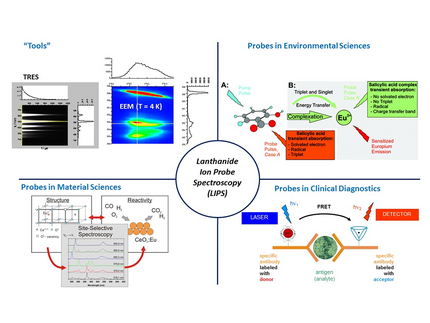Lanthanide spectroscopy
Our research focuses on laser-based optical spectroscopy. Time-resolved absorption and emission spectroscopy are used to investigate various organic and inorganic materials in both solid and liquid phases. The experiments address both fundamental and application-oriented questions, with a current emphasis on the study of lanthanoids and their potential applications.
Lanthanoids (Ln(III)) are highly useful luminescent probes and are widely applied in life and environmental sciences as well as in clinical diagnostics. Due to their unique photophysical properties—such as long emission kinetics and narrow-band emission spectra—they are particularly well-suited for luminescence-based analytics and speciation in complex matrices. Time-resolved detection methods allow for efficient suppression of interfering background signals, enabling extremely low detection limits, for example, in sandwich immunoassays.
For investigations in aqueous systems, Eu(III) is primarily used as aluminescent probe, though Dy(III), Sm(III), and Tb(III) are also suitable. The emission parameters of Eu(III) are particularly sensitive to the physicochemical properties of the first (and second) coordination sphere. The emission kinetics of this lanthanoid ion vary depending on the ligands, ranging from a few microseconds to milliseconds, while the spectral position and intensity of different transitions are influenced by the symmetry and type of ligands. The specific electronic characteristics of Eu(III)—such as the combination of magnetic and induced electric transitions, as well as the absence of degeneracy in an electronic transition—significantly determine its properties.
| Experimental Technique | Information | Special Features |
|---|---|---|
| Absorption spectroscopy | Absorption spectra | UV/Vis - NIR spectral range |
| Steady-state emission spectroscopy | Excitation and emission spectra (fluorescence, phosphorescence) | UV/Vis - NIR spectral range |
| Time-resolved emission spectroscopy (TCSPC, box car, Streak camera) | Luminescence decay kinetics | ps to ms time range |
| Pump-probe techniques | Transient absorption | sub-ps to ns time range |
| Flashphotolysis | Transient absorption | ns to µs time range |
High resolution emission spectroscopy in condesend phase (fluorescence line narrowing, Shpol´skii spectroscopy) | Luminescence spectra (reduction of inhomogenous line broadening) - Measurements at T = 4 K (or 77 K) | Vis - NIR spectral range |
| Raman microscopy | Raman spectra; Imaging | Laser wavelengths: 532 nm and 785 nm |
| TPR / TPO experiments | Oxidation and reduction properties of solids |

